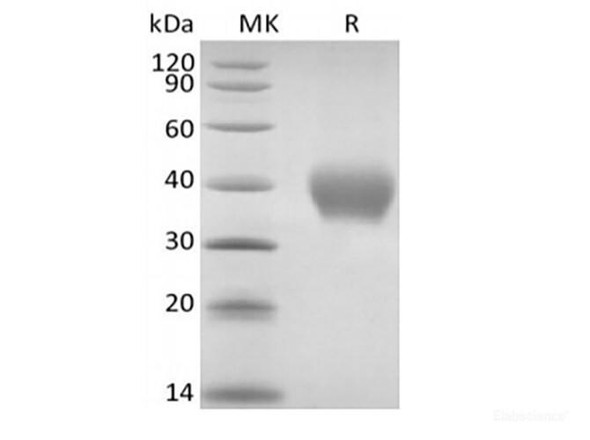Description
| Product Name: | Recombinant Mouse TNF Receptor II/TNF RII/TNFRSF1B/CD120b (C-6His-Avi) Biotinylated |
| Product Code: | RPES6668 |
| Size: | 20µg |
| Species: | Mouse |
| Expression Host: | HEK293 Cells |
| Synonyms: | Tumor necrosis factor receptor superfamily member 1b, Tnfrsf1b |
| Mol Mass: | 28.2 kDa |
| AP Mol Mass: | 35-50 kDa |
| Tag: | C-6His-Avi |
| Purity: | > 95 % as determined by reducing SDS-PAGE. |
| Endotoxin Level: | < 1.0 EU per μg of the protein as determined by the LAL method. |
| Bio Activity: | Testing in progress |
| Sequence: | Val23-Gly258 |
| Accession: | Q545P4 |
| Storage: | Generally, lyophilized proteins are stable for up to 12 months when stored at -20 to -80°C. Reconstituted protein solution can be stored at 4-8°C for 2-7 days. Aliquots of reconstituted samples are stable at < -20°C for 3 months. |
| Shipping: | This product is provided as lyophilized powder which is shipped with ice packs. |
| Formulation: | Lyophilized from a 0.2 μm filtered solution of PBS, pH 7.4. Normally 5 % - 8 % trehalose, mannitol and 0.01% Tween80 are added as protectants before lyophilization. Please refer to the specific buffer information in the printed manual. |
| Reconstitution: | Please refer to the printed manual for detailed information. |
| Background: | Tumor Necrosis Factor Receptor Superfamily Member 1B (TNFRSF1B) is a member of the Tumor Necrosis Factor Receptor Superfamily. TNFRSF1B contains four TNFR-Cys repeats. TNFRSF1B can be cleaved into the following 2 chains: Tumor necrosis factor receptor superfamily member 1b and membrane form and Tumor necrosis factor-binding protein 2. TNFRSF1B is a receptor with high affinity for TNFSF2/TNF-α and approximately 5-fold lower affinity for homotrimeric TNFSF1/lymphotoxin-α. TNFRSF1B mediates most of the metabolic effects of TNF-α. TNF-α-induced apoptosis suggests that it regulates TNF-α function by antagonizing its biological activity. |






